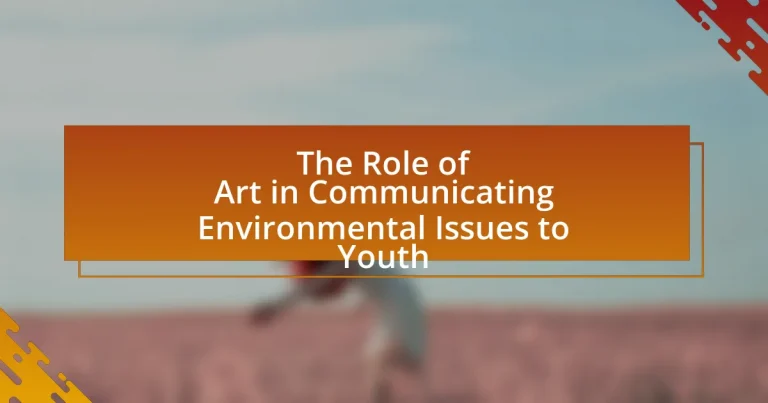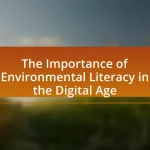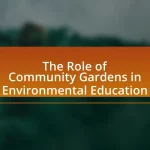The article examines the role of art in communicating environmental issues to youth, highlighting how various artistic forms—such as visual art, music, and performance—effectively engage emotions and simplify complex ecological concepts. It discusses the effectiveness of visual arts, including murals and installations, in raising awareness and fostering empathy towards environmental challenges. The article also explores the emotional impact of art on youth perceptions, the importance of integrating environmental themes into art education, and the potential benefits of community art initiatives in promoting environmental stewardship. Additionally, it outlines practical steps for youth to use art for advocacy and the resources available for those interested in merging art with environmental activism.
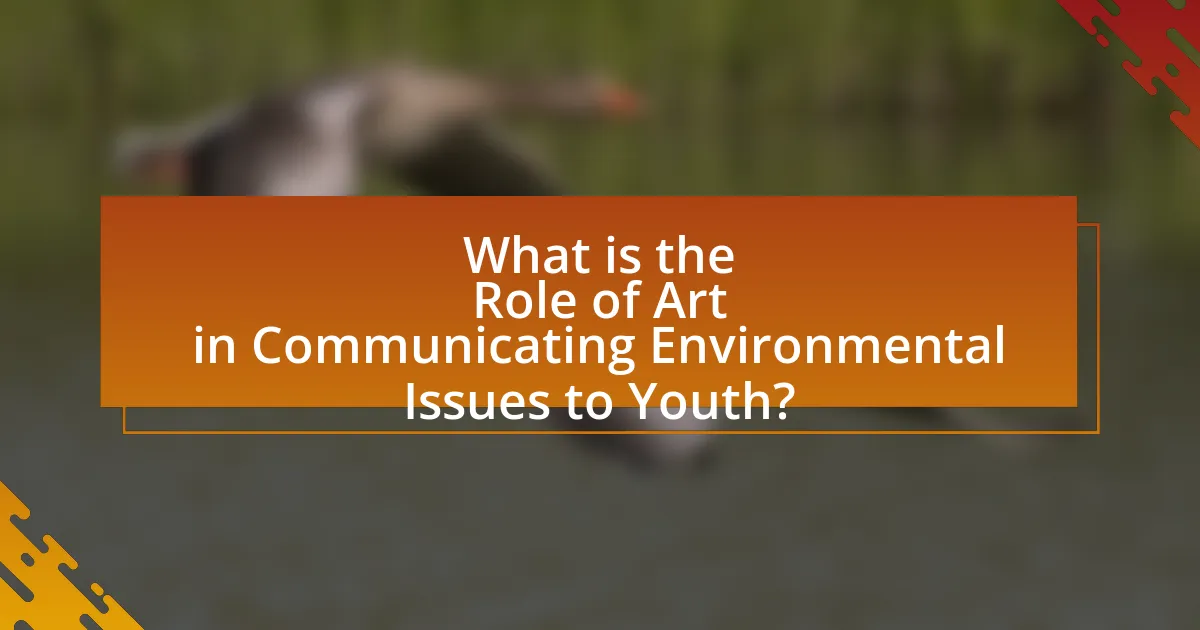
What is the Role of Art in Communicating Environmental Issues to Youth?
Art plays a crucial role in communicating environmental issues to youth by engaging their emotions and fostering a deeper understanding of complex topics. Through various forms such as visual art, music, and performance, art can simplify intricate environmental concepts, making them more relatable and accessible. For instance, studies have shown that youth are more likely to engage with environmental themes when presented through artistic mediums, as these approaches can evoke empathy and inspire action. Research conducted by the National Endowment for the Arts indicates that art-based programs significantly enhance environmental awareness among young people, demonstrating that creative expression can effectively convey urgent ecological messages.
How does art serve as a medium for environmental communication?
Art serves as a powerful medium for environmental communication by visually conveying complex ecological issues in an accessible and engaging manner. Through various forms such as paintings, installations, and performances, artists can evoke emotional responses and raise awareness about environmental challenges like climate change, pollution, and biodiversity loss. For instance, the “Ice Watch” project, where large blocks of ice were placed in urban settings, highlighted the urgency of climate change by making the melting ice a tangible experience for viewers. This direct interaction fosters a deeper understanding and encourages dialogue among audiences, particularly youth, about their role in environmental stewardship.
What types of art are most effective in conveying environmental messages?
Visual art, particularly installations and murals, is most effective in conveying environmental messages. These forms of art engage viewers through their immersive and often large-scale nature, making complex environmental issues more accessible and emotionally resonant. For instance, the “The Ocean Cleanup” project utilizes art installations to raise awareness about ocean pollution, effectively combining aesthetics with activism. Additionally, street art, such as the works of Banksy, often addresses environmental themes, prompting public discourse and reflection on ecological issues. Studies indicate that visual representations can evoke stronger emotional responses, leading to increased awareness and action regarding environmental concerns.
How does the emotional impact of art influence youth perceptions of environmental issues?
The emotional impact of art significantly influences youth perceptions of environmental issues by fostering empathy and awareness. Art evokes strong feelings, which can lead to a deeper understanding of environmental challenges. For instance, studies have shown that visual art depicting climate change can increase concern among young audiences, prompting them to engage in environmental advocacy. Research published in the journal “Environmental Education Research” indicates that emotionally charged art can enhance the likelihood of youth participating in sustainability initiatives, as it creates a personal connection to the issues presented. This emotional resonance helps to transform abstract environmental concepts into relatable experiences, ultimately shaping more proactive attitudes toward environmental stewardship among young people.
Why is it important to engage youth in environmental issues through art?
Engaging youth in environmental issues through art is important because it fosters creativity and emotional connection, making complex topics more relatable. Art serves as a powerful medium for expression, allowing young people to visualize and communicate their concerns about the environment effectively. Studies show that youth who participate in artistic projects related to environmental themes are more likely to develop a sense of responsibility and advocacy for sustainability. For instance, a report by the National Endowment for the Arts highlights that art can enhance environmental awareness and inspire action among younger generations, demonstrating its effectiveness in promoting engagement with critical issues.
What are the potential benefits of using art to raise environmental awareness among young people?
Using art to raise environmental awareness among young people can enhance engagement and foster emotional connections to environmental issues. Art stimulates creativity and critical thinking, allowing youth to express their concerns and ideas about the environment in impactful ways. Research indicates that visual and performing arts can effectively communicate complex environmental concepts, making them more accessible and relatable. For instance, a study published in the Journal of Environmental Education Research found that students who participated in art-based environmental programs demonstrated increased knowledge and concern for environmental issues compared to those who did not engage in such activities. This suggests that art not only raises awareness but also encourages proactive attitudes towards environmental stewardship among young audiences.
How does art foster a sense of responsibility and action towards environmental issues in youth?
Art fosters a sense of responsibility and action towards environmental issues in youth by engaging their emotions and encouraging critical thinking about ecological challenges. Through various forms of artistic expression, such as visual arts, music, and performance, young people can explore and communicate their concerns about the environment, which enhances their awareness and understanding of these issues. For instance, studies have shown that youth who participate in environmental art projects are more likely to develop a personal connection to nature and feel empowered to take action, as evidenced by initiatives like the “Art for the Earth” program, which combines creativity with environmental education. This connection often translates into advocacy and community involvement, demonstrating that art can be a powerful catalyst for environmental stewardship among young individuals.
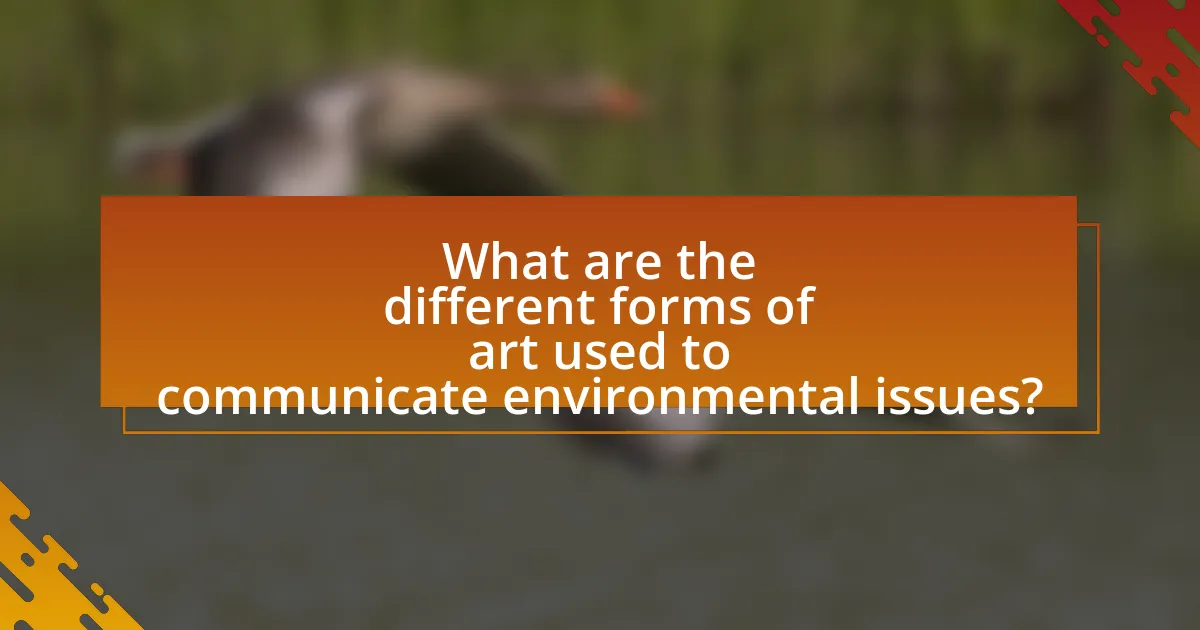
What are the different forms of art used to communicate environmental issues?
Different forms of art used to communicate environmental issues include visual arts, performance arts, literature, music, and digital media. Visual arts, such as painting and sculpture, often depict environmental themes and raise awareness through imagery. Performance arts, including theater and dance, can convey powerful messages about ecological concerns through storytelling and movement. Literature, encompassing poetry and prose, allows for deep exploration of environmental narratives and ethical dilemmas. Music serves as a universal language to inspire action and evoke emotions related to environmental challenges. Digital media, including video and social media campaigns, effectively reach a broad audience, utilizing technology to engage and inform about pressing environmental issues. Each of these art forms plays a crucial role in fostering dialogue and encouraging action among youth regarding environmental sustainability.
How do visual arts contribute to environmental awareness?
Visual arts contribute to environmental awareness by effectively communicating complex ecological issues through visual representation. Artists utilize various mediums, such as painting, sculpture, and photography, to depict environmental challenges like climate change, pollution, and habitat destruction, making these issues more relatable and understandable to the public. For instance, the “Earth Day” art installations have historically engaged communities in discussions about sustainability, demonstrating how visual arts can inspire action and foster a sense of responsibility towards the environment. Studies have shown that visual storytelling can evoke emotional responses, leading to increased awareness and motivation to engage in environmental conservation efforts.
What role do murals and street art play in environmental activism?
Murals and street art serve as powerful tools in environmental activism by visually communicating urgent ecological messages to the public. These art forms engage communities, raise awareness about environmental issues, and inspire action through their accessibility and emotional impact. For instance, a study by the University of California found that murals depicting climate change can increase public understanding and concern, leading to greater community involvement in sustainability initiatives. Additionally, street art often transforms neglected urban spaces into vibrant platforms for dialogue, making environmental themes more relatable and urgent to diverse audiences.
How can photography be used to highlight environmental challenges?
Photography can be used to highlight environmental challenges by visually documenting the impact of human activities on ecosystems and raising awareness about issues such as climate change, pollution, and habitat destruction. Through powerful imagery, photographers can capture the stark realities of environmental degradation, such as deforestation, melting glaciers, and wildlife endangerment, making these issues more relatable and urgent to the audience. For instance, the work of renowned photographers like Sebastião Salgado has brought global attention to deforestation in the Amazon and the plight of displaced communities, effectively mobilizing public opinion and action. By presenting compelling visual narratives, photography serves as a critical tool for education and advocacy, inspiring youth to engage with and address environmental challenges.
What is the significance of performing arts in environmental communication?
Performing arts play a crucial role in environmental communication by engaging audiences emotionally and fostering a deeper understanding of ecological issues. Through storytelling, music, and visual elements, performing arts can illustrate complex environmental concepts in relatable ways, making them accessible to diverse audiences, particularly youth. For instance, productions like “The Lion King” have raised awareness about wildlife conservation, demonstrating how performance can inspire action and advocacy. Research indicates that experiential learning through the arts enhances retention of environmental messages, as seen in studies conducted by the National Endowment for the Arts, which highlight the effectiveness of arts-based education in promoting environmental stewardship among young people.
How do theater and dance convey messages about environmental issues?
Theater and dance convey messages about environmental issues by using storytelling and physical expression to engage audiences emotionally and intellectually. Through narratives that highlight the consequences of environmental degradation, performances can illustrate the urgency of climate change, pollution, and biodiversity loss. For instance, productions like “The Lion King” have been used to raise awareness about wildlife conservation, while dance pieces often incorporate movements that mimic natural elements, emphasizing the interconnectedness of humans and nature. Research shows that arts-based approaches can enhance understanding and retention of environmental messages, making them more impactful for youth audiences.
What impact do music and spoken word have on youth engagement with environmental topics?
Music and spoken word significantly enhance youth engagement with environmental topics by making complex issues more relatable and emotionally resonant. These art forms utilize rhythm, melody, and storytelling to capture attention and foster a sense of community among young audiences. Research indicates that youth are more likely to connect with environmental messages when presented through creative mediums, as evidenced by initiatives like the “Youth Climate Summit,” where performances by artists led to increased participation and awareness among attendees. Additionally, studies show that songs addressing environmental themes can lead to higher retention of information and inspire action, as seen in campaigns like “1 Million Acts of Green,” which leveraged music to mobilize youth for environmental activism.
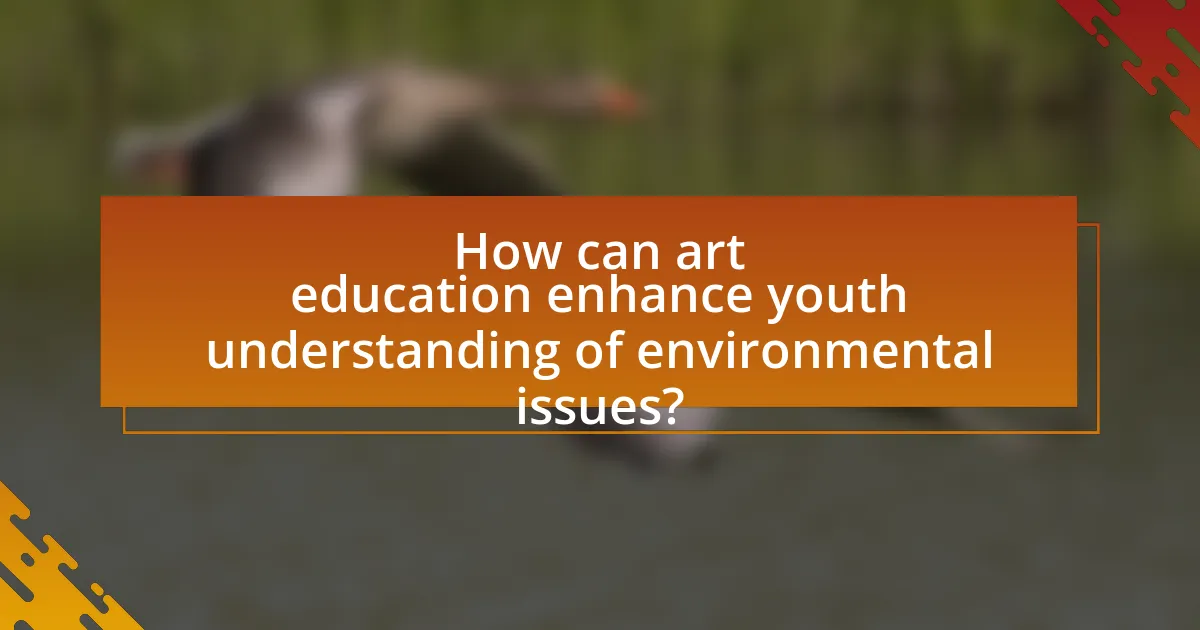
How can art education enhance youth understanding of environmental issues?
Art education enhances youth understanding of environmental issues by fostering creativity and critical thinking, which allows students to engage with and interpret complex ecological concepts. Through various artistic mediums, such as painting, sculpture, and digital art, students can express their perspectives on environmental challenges, making abstract issues more tangible and relatable. Research indicates that experiential learning in art can lead to increased environmental awareness; for instance, a study published in the Journal of Environmental Education Research found that students who participated in art-based projects demonstrated a deeper understanding of sustainability and ecological interconnections. This hands-on approach not only cultivates empathy towards nature but also empowers youth to advocate for environmental stewardship through their artistic expressions.
What are effective strategies for integrating environmental themes into art curricula?
Effective strategies for integrating environmental themes into art curricula include project-based learning, collaboration with environmental organizations, and the use of sustainable materials. Project-based learning allows students to engage in hands-on activities that explore environmental issues, fostering critical thinking and creativity. Collaborating with environmental organizations provides students with real-world context and resources, enhancing their understanding of ecological challenges. Utilizing sustainable materials not only teaches students about environmental responsibility but also encourages innovative artistic practices. These strategies have been shown to increase student awareness and engagement with environmental issues, as evidenced by programs that report improved student attitudes towards sustainability and environmental stewardship.
How can educators use art projects to promote environmental stewardship among students?
Educators can use art projects to promote environmental stewardship among students by integrating themes of sustainability and ecological awareness into creative activities. For instance, projects like creating recycled art or nature-inspired installations encourage students to explore environmental issues while expressing their creativity. Research indicates that engaging in hands-on art activities fosters a deeper understanding of environmental concepts, as students actively participate in the learning process. A study published in the Journal of Environmental Education found that students who participated in art-based environmental education showed increased awareness and concern for ecological issues, demonstrating the effectiveness of art as a tool for promoting stewardship.
What role do community art initiatives play in fostering environmental awareness?
Community art initiatives play a crucial role in fostering environmental awareness by engaging local populations in creative expressions that highlight ecological issues. These initiatives often utilize visual art, performances, and interactive installations to communicate the importance of environmental stewardship, making complex topics more accessible and relatable. For instance, studies have shown that community murals depicting environmental themes can increase public engagement and dialogue about sustainability, as seen in projects like the “Eco-Mural Project” in Philadelphia, which aimed to educate residents about local environmental challenges. By involving community members in the artistic process, these initiatives not only raise awareness but also empower individuals to take action towards environmental conservation.
How can collaborative art projects empower youth to address local environmental issues?
Collaborative art projects empower youth to address local environmental issues by fostering creativity, teamwork, and critical thinking skills. These projects enable young people to express their concerns about environmental challenges through various artistic mediums, such as murals, installations, and performances. For instance, a study by the University of California found that youth engaged in community art initiatives reported increased awareness of local environmental issues and a greater sense of agency in advocating for change. By working together, participants not only enhance their artistic abilities but also develop a collective voice that can influence community perceptions and actions regarding environmental sustainability.
What practical steps can youth take to use art for environmental advocacy?
Youth can use art for environmental advocacy by creating awareness campaigns that incorporate visual art, performance, and digital media. They can organize community art projects, such as murals or installations, that highlight local environmental issues, thereby engaging the public and sparking conversations. Additionally, youth can participate in art competitions focused on environmental themes, which can amplify their messages through social media platforms. Research shows that visual storytelling significantly impacts public perception of environmental issues, making art a powerful tool for advocacy.
How can young artists effectively share their environmental messages with a wider audience?
Young artists can effectively share their environmental messages with a wider audience by utilizing social media platforms, engaging in community art projects, and collaborating with environmental organizations. Social media allows artists to reach diverse demographics quickly; for instance, platforms like Instagram and TikTok have millions of active users, enabling artists to showcase their work and messages to a global audience. Community art projects, such as murals or installations, can raise local awareness and foster discussions about environmental issues, as evidenced by initiatives like the “Art for the Earth” project, which has successfully engaged communities in environmental dialogues. Collaborating with environmental organizations can amplify their reach and credibility, as partnerships can provide resources and platforms for artists to present their work at events or campaigns focused on sustainability.
What resources are available for youth interested in combining art and environmental activism?
Youth interested in combining art and environmental activism can access various resources, including organizations, online platforms, and educational programs. Notable organizations such as the Alliance for the Arts in Research Universities (AARU) provide grants and support for projects that merge art and environmental advocacy. Online platforms like Instagram and TikTok serve as spaces for youth to share their artistic expressions related to environmental issues, reaching a broad audience. Additionally, educational programs such as the EcoArt Network offer workshops and resources that teach young artists how to effectively communicate environmental messages through their art. These resources empower youth to engage creatively with environmental activism, fostering awareness and action.
